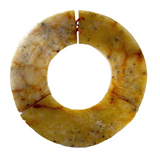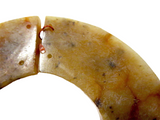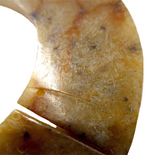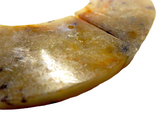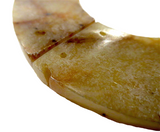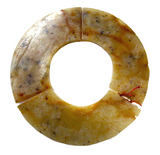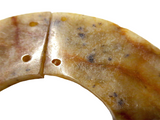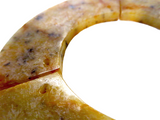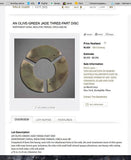Carved Jade Bi. Segmented into three sections. Each section in the shape of a huang. Each huang section with two holes near its edge. Semi-translucent material. The Bi is known as the symbol of heaven. Approximately 4 1/8" diameter. The aperture is approximately 1 3/4" diameter. Neolithic Period circa 2000 B.C.
For A Similar Example:
Chinese Archaic Jades In The British Museum, By Soame Jenyns, 1951, Plate XIX,3, and #6 Listed As Chou. Also See Bahr, pls. 10, 11 and 13.
For Another Similar Example:
Ancient Chinese Jades From The Buffalo Museum Of Science - The China Institute In America April 3 through June 15, 1975. Item 50. Dated As Shang Or Western Chou.
For Another Similar Example:
Chinese Jade from the Neolithic to the Qing - by Jessica Rawson , British Museum, 1995, p. 159, fig. 1, where they are dated Neolithic or Shang dynasty, 2000-1500 BC.
For A Similar Bi Disk:
Christie's New York - The Robert Hatfield Ellsworth Part III - Chinese Works Of Art: Qing Ceramics, Glass And Jade Carvings - March 19, 2015 - Sale #11420, Lot #505 Which Realized $5,625USD.
Lot Description
AN OLIVE-GREEN JADE THREE-PART DISC
NORTHWEST CHINA, NEOLITHIC PERIOD, CIRCA 2000 BC
Comprised of three thin huang, each with two attachment holes at the ends, the semi-translucent stone of olive-green tone with some brown-grey inclusions, the sides with small buff-colored opaque alterations, one huang with cutting lines on both sides, with soft polish
4 ¾ in. (11.8 cm.) diameter, box
SEE LAST IMAGE FOR CHRISTIE'S LOT DETAILS
For A Similar Example:
The Harvard Art Museum:
Object Number 1943.50.602.A-C;
Title
Jade Disk in Three Segments
Classification
Ritual Implements
Work Type
disk
Date
16th-8th century BCE
Shang dynasty to Western Zhou period
Medium
Translucent, light greenish gray nephrite with light brown markings and creamy white calcified streaks
Dimensions
ensemble: Diam. 14.5 x Thickness 0.5 cm (5 11/16 x 3/16 in.)
92 Disk in Three Segments
Translucent, light greenish gray stone with light brown markings and creamy white calcified streaks. The three segments are of unequal size, their arcs measuring about 130, 102, and 128 degrees. A slightly curved ledge on the underside of one segment (c) suggests the use of a very large swinging saw; an apparently straight ledge—intersected by the perforation—remains on another segment (a). Near the adjoining edges of the three segments, small conical holes have been drilled, which would permit the pieces to be held together by thongs or wires. Shang or Western Chou(?).










